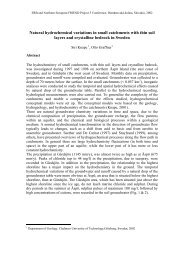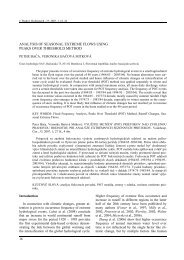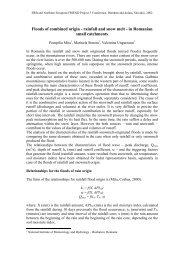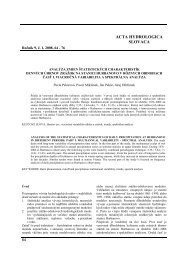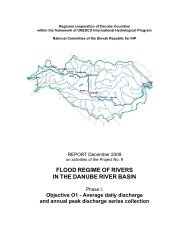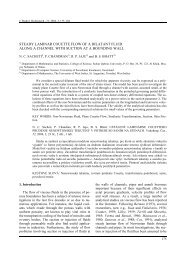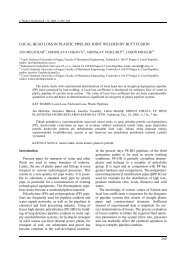TIME SERIES ANALYSIS OF HYDROLOGIC DATA FOR WATER ...
TIME SERIES ANALYSIS OF HYDROLOGIC DATA FOR WATER ...
TIME SERIES ANALYSIS OF HYDROLOGIC DATA FOR WATER ...
Create successful ePaper yourself
Turn your PDF publications into a flip-book with our unique Google optimized e-Paper software.
Time series analysis of hydrologic data for water resources planning and management: a reviewin this direction should also consider contemporarymultiple comparison tests in addition to the commonlyused tests for checking homogeneity in thehydrologic time series.In several studies, a hydrologic time series is declaredstationary based on the randomness andtrend tests only. Specific stationarity tests such asparametric t-tests and nonparametric Mann-Whitney Test have not been employed. Furthermore,the detection of periodicity and persistence isignored in most studies involving hydrologic timeseries analyses. As every time series characteristicis very important for water resources planning andmanagement, future studies should fulfill this gap.During last two-three decades, time series analyseshave been applied for the impact assessment ofclimatic change and variability by several researchersworldwide. Hydrological research strongly suggeststhat the well-known ‘greenhouse effect’ willalter the timing and magnitude of runoff and soilmoisture, change lake levels, and affect water quality.Such changes raise the possibility of environmentaland socioeconomic dislocations, and theyhave important implications for the planning andmanagement of water resources in the future(Gleick, 1989; IPCC, 1996). Moreover, with presentglobal warming perspective, many researchershave used time series analysis techniques to assessthe impacts of El Nino and La Nina (e.g., Cimino etal., 1999). Future research should address the applicationsof time series analysis techniques in theseexciting areas in order to make these applicationsrobust and widely acceptable. To this end, the qualityof hydrological or climatological data will playa central role in proving these techniques useful andreliable.The pre-processing of time series is sometimesrequired as per the nature and state of records, but itis often neglected. For example, the extension ofthe data for their proper use and the filling of missingdata in the series; these are often true in practicefor natural time series records (Nawaj and Adeloye,1999). Future time series studies should take intoaccount all the pre-processing requirements in thetime series prior to applying the techniques of timeseries analysis. The methodologies for the extensionof time series data are described in Hirsch etal. (1993), whereas Salas (1993) presents the proceduresfor both data filling and extension.It is also obvious from the review that severalgroundwater-level time series have been used in thepast without prior time series analyses. Hence, thereis an urgent need for introducing the time seriesanalysis in this important area. In fact, time seriesof each component in the water cycle (e.g., evaporation,transpiration, infiltration, interflow, quickflow,baseflow, streamflow, spring flow, percolation,groundwater discharge, etc.) must be tested forthe validity of the basic assumptions associatedwith different statistical analyses. Unfortunately,the most time series of these hydrologic variablesare used without time series analyses. Thus, there isan urgent need to promote awareness about theimportance of time series analysis in handling nontraditionalhydrologic time series.10. ConclusionsTime series analysis has been applied in a varietyof fields in the past such as hydrology, climatology,geology, oceanography, seismology, etc. In thispaper, a review on the application of time seriesanalysis techniques in hydrology and climatology ispresented. Based on the comprehensive review, it isapparent that precipitation and streamflow are themajor hydrologic variables followed by temperatureand surface water quality, which attracted the attentionof worldwide researchers for applying timeseries analysis techniques. The use of standard statisticaltests and the performance evaluation ofsome statistical tests have been a major focus ofapplied research. On the other hand, less number ofstudies on the development of a novel approach/methodologyor the modification of existingapproaches for time series analysis is reported inthe literature. Furthermore, not a single study isreported to date covering all aspects (i.e., all basicproperties) of the hydrologic time series analysis.Most researchers have used the Kendall Test or theSeasonal Kendall Test for detecting tends, and theremaining trend detection tests as well as otherproperties of the time series (i.e., stationarity, homogeneity,periodicity and persistence) have beenignored. The main reason behind this ignorance isprobably the lack of awareness about these timeseries analysis techniques and/or the negligence byresearchers. Therefore, future studies should bedirected towards fulfilling these shortcomings.Based on the reviews presented, the needs for futuretime series-based research in the fields of hydrologyand climatology have been identified thatcan serve as guidelines for both researchers andpracticing water resources engineers or scientists.Acknowledgement. The authors gratefully acknowledgethe financial support provided by the Indian253



